 |
Picks is a monthly sampling of Japan's art scene, offering short reviews of exhibitions at museums and galleries in recent weeks, with an emphasis on contemporary art by young artists. |
 |
 |
 |
1 February 2010 |
 |
| 1 | 2 | |
 |
|
 |
 |
|
|
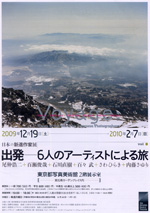 |
 |
Departure: Travels of 6 Artists
|
| 12 December 2009 - 7 February 2010 |
Tokyo Metropolitan Museum of Photography
(Tokyo) |
 |
| These photos taken in transit by Koji Onaka, Toshiya Momose, Naoki Ishikawa, Takeshi Dodo, Hiraki Sawa and Sayuri Naito collectively suggest a marked change in the way contemporary photographers approach their journeys. The romantic impulse to wander the world in search of encounters with the unknown, leaving all to chance, seems to have been replaced by a desire to meticulously capture the details of scenes at preselected destinations. There is a sense of calm and maturity in this work, but also something small about it. Perhaps these artists typify an era when the photographer's own presence has become less substantial. |
|
|
 |
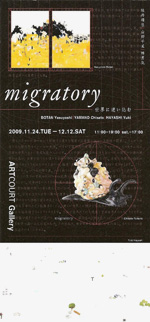 |
 |
| Yuki Hayashi, Yasuyoshi Botan, Chisato Yamano: migratory - lost in the world |
| 24 November - 12 December 2009 |
Artcourt Gallery
(Kyoto) |
 |
| Three artists of disparate genres join forces here: Yuki Hayashi (film), Yasuyoshi Botan (painting), and Chisato Yamano (ceramics). What they share in common is a sharp eye applied to revisiting and reinventing everyday encounters and experiences. Botan, who constructs installations from paintings, and Yamano, who creates worlds full of imagination and warmth, offer superlative works, but the most compelling is a masterpiece by Hayashi, his finest (and largest) animation work yet. |
|
|
|
|

|
 |
 |
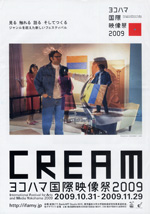 |
|
CREAM: International Festival for Arts and Media Yokohama 2009 |
| 31 October - 29 November 2009 |
Shinko Pier and BankART Studio NYK
(Kanagawa) |
 |
| Over 70 artists from around the world participated in CREAM, of which the standout works were Christian Marclay's Video Quartet and Fuyuki Yamakawa's The Voice-Over. Marclay has created a true audio-visual "quartet" by combining random snippets from countless films of people singing, playing instruments, or otherwise making noise, and projecting the images simultaneously on four screens. Yamakawa has interweaved world historical events with personal history through the voice of his own father, a TV announcer. By minimizing visual imagery and placing sound -- and the tactile vibrations produced by sound -- at the forefront of his work, Yamakawa offers new possibilities for video art in this image-saturated age. |
|
|
 |
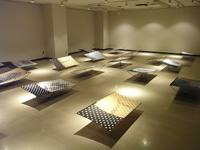 |
|
|
Ken Kagajo |
| 25 November - 5 December 2009 |
|
Ishida Taiseisha Hall
(Kyoto) |
 |
| In his dyed fabric works, Kagajo has taken an abstract, action-painterly approach that utilizes blurs, bleeds and blotches that would normally be considered fatal errors in the artisan's world. Here he partially bleaches commercial polka-dot patterned cloth to produce a subtle layered effect between the bleached and unbleached sections. |
|
|
|
|
|
|
|

|
 |
 |
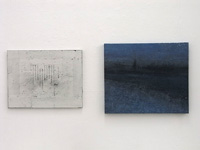 |
 |
Hiroko Toyoshima: Poems and Paintings - from Kenji Miyazawa's Spring and Asura
|
| 24 - 29 November 2009 |
CUBIC gallery ITEZA
(Kyoto) |
 |
| Toyoshima displays verses by poet Kenji Miyazawa (1896-1933) alongside her own Nihonga-style paintings. Whether one views the pictures through the prism of the poetry, or vice-versa, the result is a profound and flavorful experience. Though visual artworks inspired by text are hardly uncommon, Toyoshima's paintings are particularly well-executed. Lately we have not seen many young Nihonga artists step into the limelight, but Toyoshima's progress is impressive and bodes well for the future. |
|
|
 |
 |
| Spiro Design: Synchro-Theism |
| 25 November - 6 December 2009 |
CASO
(Osaka) |
 |
| Hiromi Uno, Shimpei Kawai, and Kanako Tsunemi have all created organic-looking objects inspired by the natural world -- plants, animals, cells, bacteria. Perceiving a synchronicity in the work of the three artists, curator Ken Tanimoto has brought them together to collaborate on works under the collective name Spiro Design, describing them as "another earth creators." The show's title is a term the artists invented to evoke a view of life and nature that is neither mono- nor polytheistic. |
|

|
 |
 |
 |
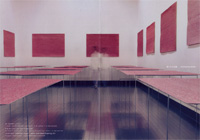 |
|
| Heartbeat-Sasaki |
| 10 November - 19 December 2009 |
Dai-ichi Life South Gallery
(Tokyo) |
 |
| The artist formally known as Heartbeat Sasaki devotes himself to artistic renderings of the human heartbeat. This installation, at the Dai-ichi Life Insurance Co.'s downtown Tokyo gallery, features some thirty massive red-ink drawings, some laid flat on tables, others on walls. The panels are covered with zigzag patterns that faithfully reproduce the rhythms of the heart. The artist's compulsive, even desperate, effort to get his life down on paper reflects an anxiety about death that makes this work a contemporary allusion to the adage memento mori. |
|
|
|
|
 |
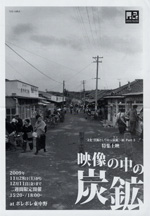 |
 |
| Pitfall ("Coal Mines on Film" series) |
| 28 November - 11 December 2009 |
Polepole Higashinakano
(Tokyo) |
 |
| As part of its exhibition "The Coal Mine as Cultural Resource," the Meguro Museum of Art recently screened a series of films featuring coal mines. Otoshiana (Pitfall), a 1962 work by Hiroshi Teshigahara, was shown at Polepole, a documentary-oriented neighborhood cinema in Higashinakano, Tokyo. Boasting a script by Kobo Abe, musical direction by Toru Takemitsu, and a cast headed by Kunie Tanaka, who plays a mysterious murderer in a white suit, this is a suspense story set in a mining town that mixes the real and surreal in a semi-documentary format, with large dollops of the absurdist humor for which Teshigahara and Abe are known. |
|
|
|
|
|
|
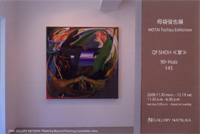 |
 |
| Toshiya Motai |
30 November - 19 December 2009
|
Gallery Natsuka
(Tokyo) |
 |
| Motai's paintings juxtapose the Russian Orthodox icons of Andrei Rublev with images of the hands of Amidha Buddha. Even more intriguing than the art, however, is the way Motai has cut away the edges of the paintings' backing so that it appears thinner around the periphery, like the rim of a plate. Also noteworthy is his placement of temporary partitions and tables inside the gallery to lay out his paintings and drawings, as if the space were his own studio. |
|
 |
 |
 |
| Aichi Triennale 2010 Press Conference |
| 3 December 2009 |
Tokyo Kokusai Forum Hall D5
(Tokyo) |
 |
The theme of the Aichi Triennale, which opens this coming August in Nagoya, Aichi Prefecture, is "urban festivity." As artistic director Akira Tatehata (director of the National Museum of Art, Osaka) said at a Tokyo press conference announcing the event, the theme itself doesn't matter, but the focus will indeed be on "urban" venues -- Nagoya streets and parks around facilities like the Aichi Arts Center and the Nagoya City Art Museum. Also, unlike last year's Yokohama Triennale, which highlighted performance art, this one will emphasize the performing arts: dance, music and theater.
|
|
|
|
|
 |
|